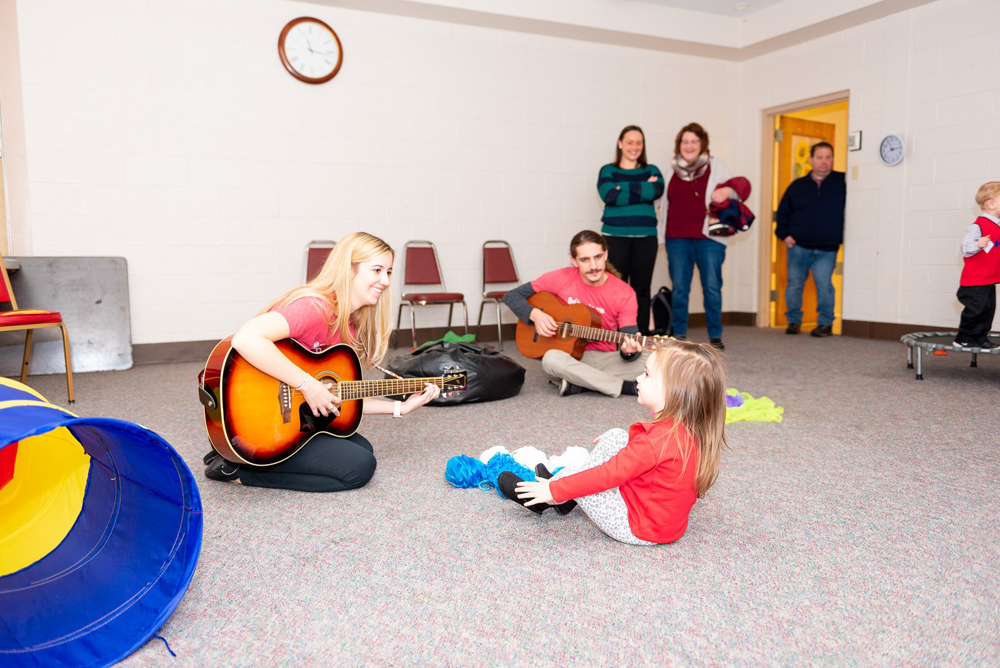Music Therapy for Neuro-Muscular Issues

Back Mountain Music Therapy, The Heyward Rooms LLC looks at individual preferences, strengths, and individual differences when working with individuals and small groups. Back Mountain Music Therapy, The Heyward Rooms LLC Board Certified therapist’s aim is to orchestrate effective relationships in musical play working towards musical goals that are clinical. Music being a domain of health. Musical engagement is a creative, reflexive, developmental process.
The twenty-month-old was wheeled in, strapped in a stroller. Only his right arm demonstrated any movement due to neuro-muscular issues the child had. The therapist decided to keep him in the stroller versus someone’s lap to give Sam the opportunity to engage independently and face to face with the therapist. Since Sam was very limited with his ability to move his limbs due to the neuro-muscular issue, the therapist decided to engage as many senses as possible. She chose a little three-headed electronic drum toy that, as tapped lit up and played a brief tune, gave feedback visually, auditory, and tactilely.
The therapist then recognized that, as she set the drum on his lap, it would provide a little vibratory stimulation to Sam’s legs as he tapped. The therapist began the session by singing hello and then took the cabasa to Sam’s arms and legs. She used a brief, little descending three-note melody, switching limbs with the cabasa at the end of each little three-note phrase. This gained Sam’s attention quickly. He remained focused on what the casaba was doing and demonstrated emotional involvement with smiles and giggles.
The palm of his hand appeared more like a weighted appendage at the bottom of his arm. The little musical light-up drum caught Sam’s attention. The therapist raised the drum and lowered it to his lap singing the descending three-note melody as she did so. She repeated the process a couple of times. Sam would follow that drum and tap on the drum heads, at the conclusion of the three-note melody, the therapist accented the last chord, as he did so.
The therapist saw Sam start to lessen his involvement and look tired. She continued the tune and got the cabasa back out, running it up and down over each arm and leg, to the three-note tune. Sam giggled and reached out toward the cabasa – this time with both hands. The therapist twirled the cabasa between his hands and pulled it away as she expanded slightly, on his three-note tune. When she pulled the cabasa away, she gave Sam a look of surprise on her face. As he giggled, she noticed a twitch of excitement in his left leg.
Repetition, Increasing Tempo, Yields the desire to Interact, Muscle Control
After a couple of sessions of this generally repeated structure, taking into account and including the minor nuances demonstrated by Sam within each structure. Sam was now beginning to kick one foot or the other to the music. The therapist would start the session with the cabasa to gain Sam’s attention and simultaneously give those muscles and limbs a little stimulating sensory stimulation. Then, the therapist would sustain the top first note, of that three-note descending melody. Sam responded by raising his arms up slightly more, before lowering to tap the drum.
The therapist then stopped raising the drum and only utilized the three-note melody to alert Sam to enter the play. Holding this first tone, gave Sam processing time to hear, activate and then raise those arms. As soon as they were up, the Therapist began her melodic decent, matching his descending arms to the drum. The therapist then gave the final third tone an exaggerated, intensified, affective chord at the piano as he hit the drum. This intensified chord gave a motivating “You did it” kind of ending.
Over the sessions, the drum taps became quicker. Sam gained more control as the therapist increased the tempo and his arms followed. Sam was gaining more muscle control by attending to and being invested in the interactive play.

